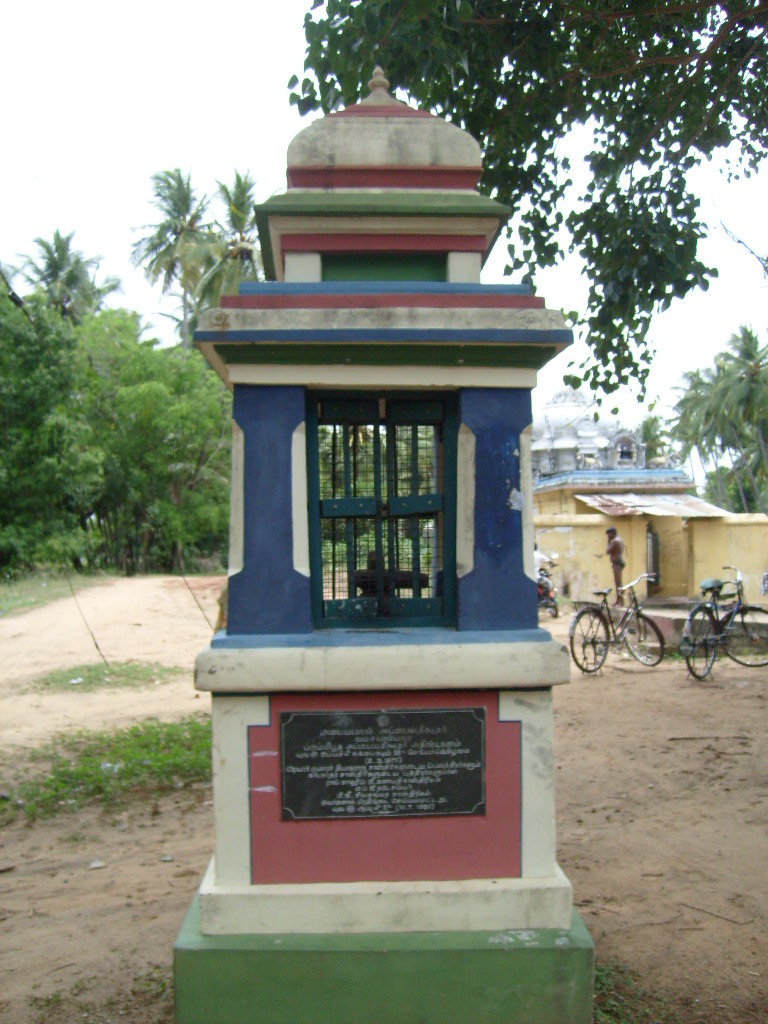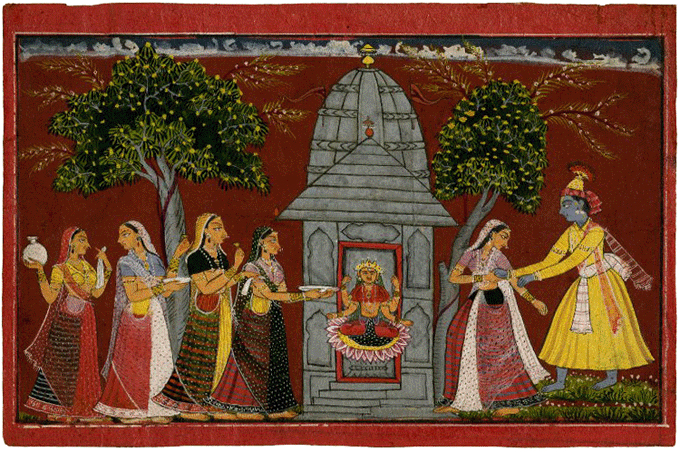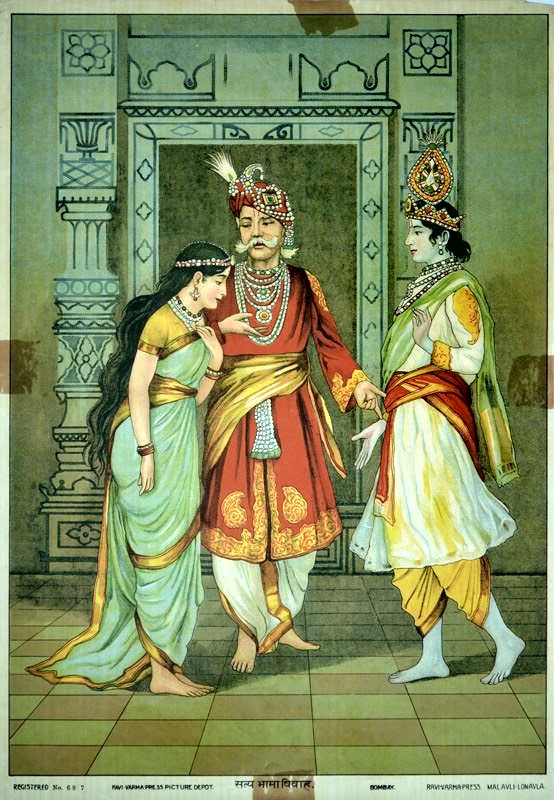|
Yadavabhyudaya
The ''Yadavabhyudaya'' () is a Sanskrit ''mahakavya'' (epic poem) by the Hindu philosopher Vedanta Desika. Written in the fourteenth century CE, the work consists of 24 cantos that describe the life of Krishna as well as the lineage of the Yadava race. The ''Yadavabhyudaya'' is regarded to be a significant work of medieval Sanskrit poetry. It holds the rare distinction of being offered a flattering commentary by the philosopher Appayya Dikshita, who belonged to the Advaita school of thought; the poet Vedanta Desika himself was a proponent of the rival Vishishtadvaita philosophy. Content Indologist Edwin Bryant describes the ''Yadavabhyudaya'' to be an "encyclopedic treatment of the Krishna-''katha'' (narrative) and ''lila'' (divine "play")". The themes of love and separation, heroism, eroticism, and various forms of '' rasa'' (aesthetic experience) are combined in the poem to describe the story of the deity. The poem begins with a number of laudatory stotras (eulogies). The ... [...More Info...] [...Related Items...] OR: [Wikipedia] [Google] [Baidu] |
Vedanta Desika
Vedanta Desika (1268–1369), also rendered Vedanta Desikan, Swami Vedanta Desika, and Thoopul Nigamantha Desikan, was an Indian polymath who wrote philosophical as well as religious and poetical works in several languages, including Sanskrit, Manipravaḷam (a Sanskritised form of literary Tamil), Tamil and Prakrit. He was an Indian philosopher, Sri Vaishnava guru, and one of the most brilliant stalwarts of Sri Vaishnavism in the post-Ramanuja period. He was a Hindu devotee, poet, Master of Acharyas (''desikan'') and a logician and mathematician. He was the disciple of Kidambi Appullar, also known as Athreya Ramanujachariar, who himself was of a master-disciple lineage that began with Ramanuja. Vedanta Desika is considered to be avatar (incarnation) of the divine bell of Venkateshvara of Tirumala by the Vadakalai sect of Sri Vaishnavism. Vedanta Desika belongs to Vishvamitra/Kaushika gotra. On the occasion of 750th anniversary of the life of Vedanta Desika, the Indian p ... [...More Info...] [...Related Items...] OR: [Wikipedia] [Google] [Baidu] |
Appayya Dikshita
Appayya Dikshita (IAST '), 1520–1593 CE, was a performer of yajñas as well as an expositor and practitioner of the Advaita Vedanta school of Hindu philosophy but with a focus on Shiva or Shiva Advaita. Life Appayya Dikshitar was born as Vinayaka Subramanian in Adayapalam, near Arani in the Tiruvannamalai district, in the Krishna Paksha of the Kanya month of Pramateecha Varsha under the Uttara Proushthapada constellation of the Hindu calendar. His father’s name was Rangarajadhwari. Appaya had the name Vinayaka Subramanya after the Namakarana or naming ceremony took place. Acharya Dikshitar or Acchan Dikshitar was the younger brother of Appayya. Appayya studied the Hindu scriptures under his Guru, Rama Kavi. He completed the fourteen Vidyas at his young age. Dikshitar travelled widely, entering into philosophical disputations and controversies in many centers of learning. He had the rare good fortune of being revered and patronized in his own lifetime by kings ... [...More Info...] [...Related Items...] OR: [Wikipedia] [Google] [Baidu] |
Rukmini
Rukmini (, ) is a Devi, Hindu goddess and the first queen of Krishna. She is described as the chief of Krishna's wives in Dvārakā. Rukmini is revered as the avatar of Lakshmi and is venerated primarily in Warkari, and Haridasa tradition, and additionally in Sri Vaishnavism. Rukmini is mainly worshipped in Maharashtra and South India. The people of Maharashtra venerate her with Vithoba (a regional form of Krishna) and call her Rakhumai. In South India, she is worshipped along with Krishna and his and his other primary consort Satyabhama. Her birthday is celebrated every year on the occasion of Rukmini Ashtami. Etymology and epithets The name ''Rukmini'' is derived from the Sanskrit word ''Rukma'' which means 'radiant', 'clear' or 'bright'. The name can also mean 'decorated with gold ornaments'. Other names and epithets include: *''Shri'' – Lakshmi *''Vaidarbhi'' – She who is from the kingdom of Vidarbha *''Bhaishmi'' – Daughter of Bhishmaka *''Rakhumai'' – Mother Rukm ... [...More Info...] [...Related Items...] OR: [Wikipedia] [Google] [Baidu] |
Hinduism
Hinduism () is an Hypernymy and hyponymy, umbrella term for a range of Indian religions, Indian List of religions and spiritual traditions#Indian religions, religious and spiritual traditions (Sampradaya, ''sampradaya''s) that are unified by adherence to the concept of ''dharma'', a Ṛta, cosmic order maintained by its followers through rituals and righteous living, as expounded in the Vedas. The word ''Hindu'' is an exonym, and while Hinduism has been called the oldest religion in the world, it has also been described by the modern term ''Sanātana Dharma'' () emphasizing its eternal nature. ''Vaidika Dharma'' () and ''Arya dharma'' are historical endonyms for Hinduism. Hinduism entails diverse systems of thought, marked by a range of shared Glossary of Hinduism terms, concepts that discuss God in Hinduism, theology, Hindu mythology, mythology, among other topics in Hindu texts, textual sources. Hindu texts have been classified into Śruti () and Smṛti (). The major Hin ... [...More Info...] [...Related Items...] OR: [Wikipedia] [Google] [Baidu] |
Bhagavad Gita
The Bhagavad Gita (; ), often referred to as the Gita (), is a Hindu texts, Hindu scripture, dated to the second or first century BCE, which forms part of the Hindu epic, epic poem Mahabharata. The Gita is a synthesis of various strands of Indian religious thought, including the Vedic concept of ''dharma'' (duty, rightful action); samkhya-based ''yoga'' and ''jnana'' (knowledge); and ''bhakti'' (devotion). Among the Hindu denominations, Hindu traditions, the text holds a unique pan-Hindu influence as the most prominent sacred text and is a central text in Vedanta and the Vaishnava, Vaishnava Hindu tradition. While traditionally attributed to the sage Veda Vyasa, the Gita is historiographically regarded as a composite work by multiple authors. Incorporating teachings from the Upanishads and the samkhya Yoga (philosophy), yoga philosophy, the Gita is set in a narrative framework of dialogue between the pandava prince Arjuna and his charioteer guide Krishna, an avatar of Vishnu, a ... [...More Info...] [...Related Items...] OR: [Wikipedia] [Google] [Baidu] |
Kurukshetra War
The Kurukshetra War (), also called the Mahabharata War, is a war described in the Hindu Indian epic poetry, epic poem ''Mahabharata'', arising from a dynastic struggle between two groups of cousins, the Kauravas and the Pandavas, for the throne of Hastinapura. The war is used as the context for the dialogues of the ''Bhagavad Gita. Background The ''Mahābhārata'' is an account of the life and deeds of several generations of a ruling dynasty called the Kuru (Hindu mythology), Kuru clan. Central to the epic is an account of a war that took place between two rival families belonging to this clan. Kurukshetra (literally "Kshetram, Region of the Kurus"), also known as Dharmakshetra (the "Region of Dharma"), was the battleground on which the Kurukshetra War was fought. The first ''Mahābhārata'' says that this site was chosen because a sin committed on land was forgiven because of the land's sanctity. The events of the war make up more than a quarter of the ''Mahabharata''. The ... [...More Info...] [...Related Items...] OR: [Wikipedia] [Google] [Baidu] |
Nyctanthes Arbor-tristis
''Nyctanthes arbor-tristis'' is a species of '' Nyctanthes'' native to South Asia and Southeast Asia.Flora of Pakistan''Nyctanthes arbor-tristis''/ref>AgroForestry Tree Database''Nyctanthes arbor-tristis'' It is commonly known as night-blooming jasmine, tree of sadness, tree of sorrow, hengra bubar, coral jasmine, as seri gading in Singapore and as shiuli in the Bengal region. Despite its common name, the species is not a "true jasmine" and not of the genus Jasminum. Names The tree is called the "tree of sorrow" because the foliage becomes droopy as blooming flowers fall off during early morning. The Latin specific epithet ''arbor-tristis'' means "sad tree". In India and Nepal, ''Nyctanthes arbor-tristis'' is known as pārijāta (पारिजात). In other Indian languages, it is known as ''harsinghar'' (Hindi), ''sephalika'' (Sanskrit), ''shiuli/shephali'' ( Bengali), ''pavalamallikai'' (Tamil), ''prajakta'' (Marathi), ''parijaata'' (Kannada), ''pavizhamalli'' (Malaya ... [...More Info...] [...Related Items...] OR: [Wikipedia] [Google] [Baidu] |
Narakasura
Naraka, also known as Narakāsura, and Bhaumāsura was an asura king, the legendary progenitor of all three dynasties of Pragjyotisha-Kamarupa, and the founding ruler of the legendary Bhauma dynasty of Pragjyotisha. Though the myths about Naraka are first mentioned in the Mahabharata, later texts embellish them. According to later post-Vedic texts such as the Brahma Purana and Vishnu Purana, he was the son of Bhudevi, fathered by the Varaha incarnation of Vishnu. He is claimed as one who established Pragjyotisha. He was slain by Krishna and Satyabhama. His son Bhagadatta—of Mahabharata fame—succeeded him. The 10th/11th-century Kalika Purana embellishes the myths further and he is claimed to have come from Mithila and said to have established the kingdom of Pragjyotisha after overthrowing the last of the Kirata kings, Ghatakasura, of the Danava dynasty. It was foretold that he would be destroyed by a later incarnation of Vishnu. His mother, the earth, sought the ... [...More Info...] [...Related Items...] OR: [Wikipedia] [Google] [Baidu] |
Satyabhama
Satyabhama (IAST'': Satyabhāmā)'' , also known as Satrajiti, is a Hindu goddess and the third queen consort of the Hindu god Krishna. Satyabhama is described as an incarnation of Bhumi, an aspect of Lakshmi. She is the goddess and the personification of the Earth. She has two sisters named Vratini and Prasvapini who are her co-wives as well. According to some traditions, she is regarded to have aided Krishna in defeating the asura Narakasura. Legend Marriage to Krishna Satyabhama was the daughter of Yadava King Satrajita, the royal treasurer of Dvaraka, who was the owner of the Syamantaka jewel. Satrajita, who secured the jewel from the sun-god Surya and would not part with it even when Krishna, the king of Dvaraka, asked for it saying it would be safe with him. Shortly thereafter, Prasena, the brother of Satrajita, went out hunting wearing the jewel but was killed by a lion. Jambavan, known for his role in the Ramayana, killed the lion and gave the jewel to his ... [...More Info...] [...Related Items...] OR: [Wikipedia] [Google] [Baidu] |
Dvārakā
Dvārakā, also known as Dvāravatī (Sanskrit द्वारका "the gated [city]", possibly meaning having many gates, or alternatively having one or several very grand gates), is a sacred historic city in the sacred literature of Hinduism, Jainism, and Buddhism. It is also alternatively spelled as Dvarika. The name Dvaraka is said to have been given to the place by Krishna, a major god in Hinduism. In the ''Mahabharata'', it was a city located in what is now Dwarka, formerly called Kushasthali, the fort of which had to be repaired by the Yadavas. In this epic, the city is described as a capital of the Anarta Kingdom. According to the ''Harivamsa'' the city was located in the region of the Sindhu Kingdom. In the Hindu epics and the Puranas, Dvaraka is called Dvaravati and is one of seven Tirtha (Hinduism), Tirtha (pilgrimage), Sapta Puri (seven sacred cities of Hinduism), for spiritual liberation. The other six are Mathura, Ayodhya (Ramayana), Ayodhya, Varanasi, Ka ... [...More Info...] [...Related Items...] OR: [Wikipedia] [Google] [Baidu] |
Kamsa
Kamsa (, ) was the tyrant ruler of the Vrishni kingdom, with its capital at Mathura, Uttar Pradesh, Mathura. He is variously described in Hindu texts, Hindu literature as either a human or an asura; The Puranas describe him as an asura, while the Harivamsa, Harivamśa describes him as an asura reborn in the body of a man. His royal house was called Bhoja; thus, another of his names was Bhojapati. He was the cousin of Devaki, the mother of the deity Krishna; Krishna ultimately fulfilled a prophecy by slaying Kamsa. Kamsa was born to King Ugrasena and Queen Padmavati. However, out of ambition, and upon the advice of his personal confidantes, Banasura and Narakasura, Kamsa decided to overthrow his father, and install himself as the King of Mathura. Therefore, upon the guidance of another advisor, Chanura, Kamsa decided to marry Asti and Prapti, the daughters of Jarasandha, King of Magadha (Mahajanapada), Magadha. After a heavenly voice prophesied that Devaki's eighth son would ... [...More Info...] [...Related Items...] OR: [Wikipedia] [Google] [Baidu] |
Mathura
Mathura () is a city and the administrative headquarters of Mathura district in the states and union territories of India, Indian state of Uttar Pradesh. It is located south-east of Delhi; and about from the town of Vrindavan. In ancient times, Mathura was an economic hub, located at the junction of important caravan (travellers), caravan routes. The 2011 Census of India estimated the population of Mathura at 441,894. In Hinduism, the birthplace of Krishna, one of the main deities in that religion, is believed to be located in Mathura at the Krishna Janmasthan Temple Complex. It is one of the Sapta Puri, the seven cities considered holy by Hindus, also is called Mokshyadayni Tirth. The Kesava Deo Temple was built in ancient times on the site of Krishna's birthplace (an underground prison). Mathura was the capital of the kingdom of Surasena, ruled by Kamsa, the maternal uncle of Krishna. Mathura is part of the Krishna circuit (Mathura, Vrindavan, Barsana, Govardhan, 48 kos pa ... [...More Info...] [...Related Items...] OR: [Wikipedia] [Google] [Baidu] |







